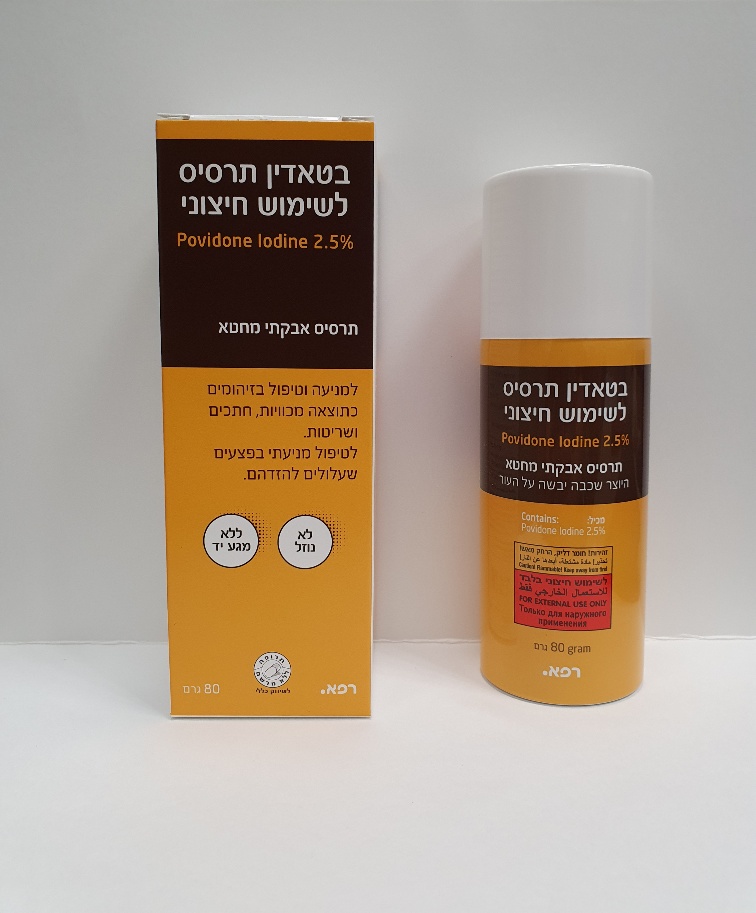Quest for the right Drug

בטאדין תרסיס לשימוש חיצוני BETADINE TOPICAL SPRAY (POVIDONE-IODINE)
תרופה במרשם
תרופה בסל
נרקוטיקה
ציטוטוקסיקה
צורת מתן:
עורי : DERMAL
צורת מינון:
אין פרטים : CUTANEOUS SPRAY, POWDER
עלון לרופא
מינוניםPosology התוויות
Indications תופעות לוואי
Adverse reactions התוויות נגד
Contraindications אינטראקציות
Interactions מינון יתר
Overdose הריון/הנקה
Pregnancy & Lactation אוכלוסיות מיוחדות
Special populations תכונות פרמקולוגיות
Pharmacological properties מידע רוקחי
Pharmaceutical particulars אזהרת שימוש
Special Warning עלון לרופא
Physicians Leaflet
Overdose : מינון יתר
4.9. Overdose Symptoms of Overdose Literature describes symptoms of intoxication upon absorption of more than 10 g of povidone-iodine. Acute iodine toxicity is manifested by abdominal symptoms like nausea, vomiting, diarrhea, dehydration, blood pressure drop, bleeding tendency (mucous membranes, kidneys), cyanosis, anuria, circulatory collapse, pulmonary edema and metabolic disorders. Upon prolonged excessive exposure with iodine, symptoms of hyperthyroidism, tachycardia, unrest, tremor and headache may occur. Systemic toxicity may result in renal dysfunction (including anuria), paresthesia, tachycardia, hypotension, circulatory failure, glottis edema causing asphyxia or pulmonary edema, seizures, fever and metabolic acidosis. Hyperthyroidism or hypothyroidism may also develop. Management of Overdose: Treatment is symptomatic and supportive. In case of severe hypotension intravenous fluid is to be administered and additional vasopressors should be administered if needed. Endotracheal intubation may be required, if a caustic injury of the upper airways causes significant swelling and edema. Vomiting should not be induced. The patient is to be kept in a position keeping the airways patent and preventing aspiration (in the case of vomiting). If the patient does not vomit and oral nutrition is possible, the intake of starchy foodstuffs (e.g., potatoes, flour, bread) may support the conversion of iodine to the less toxic iodide. If no signs of intestinal perforation are seen gastric lavage with starch solution (5% sodium thiosulfate solution (or 10 ml sodium thiosulfate IV) at intervals of 3-hours) may be given via a nasogastric probe (the gastric discharge will show a dark-blue/purple discoloration which may be used as an indication, when the lavage may be terminated). Haemodialysis will effectively flush out iodine and should be used in severe cases of iodine intoxication, especially in the presence of renal failure. Continuous venovenous hemodiafiltration will be less effective than hemodialysis. In the case of a thyroid dysfunction treatment with povidone-iodine should be discontinued Moreover, close clinical monitoring of thyroid function is indicated to allow exclusion or early diagnosis of potential hyperthyroidism. Further management will depend on the presence of any other potential symptoms such as metabolic acidosis and renal dysfunction.

שימוש לפי פנקס קופ''ח כללית 1994
לא צוין
תאריך הכללה מקורי בסל
לא צוין
הגבלות
לא צוין
מידע נוסף
